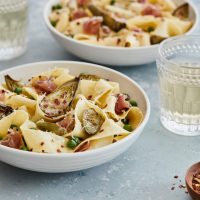PAPPARDELLE WITH ARTICHOKES, PEAS, AND PROSCIUTTO

It’s long past time to bust the myth that artichokes don’t go with wine. This pasta dish is perfectly wine friendly thanks to an assist from pasta, sweet peas, and meaty prosciutto. Chill a bottle of Sauvignon Blanc and prove it to yourself. If you can’t find fresh baby artichokes, substitute frozen artichoke hearts rather than marinated hearts.
Serves 4
Ingredients
- ¾ pound (340 g) fresh pappardelle or fresh egg pasta sheets or ½ pound (225 g) dried pappardelle
- 14 to 16 fresh baby artichokes, about 1-1/2 ounces (40 g) each, or 1 package (9 oz/ 250 g) frozen artichoke hearts (see Note)
- 1 lemon
- 6 tablespoons (90 ml) extra virgin olive oil
- 1 large yellow onion, minced
- Pinch hot red pepper flakes
- 1 sprig fresh mint
- Kosher or sea salt
- 1 cup (150 g) shelled English peas or frozen petite peas, thawed enough to separate
- 2 ounces (55 g) thinly sliced prosciutto di Parma, shredded by hand
- Freshly grated pecorino or Parmigiano Reggiano cheese
Directions
If using fresh egg pasta sheets, start at one of the sheet’s narrow ends and loosely roll the sheet like a jelly roll, leaving a 1-inch (2.5-cm) tail. With a sharp chef’s knife, cut ribbons about 5/8-inch (15-mm) wide. Grab the noodles by the exposed ends, lift them up, and they will unfurl. Repeat with the remaining sheets.
If using fresh baby artichokes: Fill a large bowl with water and add the juice of the lemon. To trim the artichokes, peel back the outer leaves until they break off at the base. Keep removing leaves until you reach the pale green heart. Cut across the top of the heart to remove the pointed leaf tips. If the stem is still attached, cut it down to ½ inch (1.25-cm), then trim the stem and base to remove any dark green or brown parts. Cut each heart in half and cut each half into 2 to 3 wedges, depending on size. Immediately place in the lemon water to prevent browning.
If using frozen artichoke hearts, thaw, cut each heart in half, then cut each half into 2 to 3 wedges, depending on size.
Bring a large pot of well-salted water to a boil over high heat.
Heat the olive oil in a large skillet over medium heat. Add the onion and hot pepper flakes and sauté until the onion is soft and sweet, about 10 minutes. Lower the heat if needed to keep the onion from browning. Add artichokes to the skillet (drained first, if fresh) along with the mint sprig, 1 cup (250 ml) water, and a generous pinch of salt. Bring to a simmer, cover, adjust the heat to maintain a gentle simmer and cook until the artichokes are almost tender, 10 to 15 minutes. There should still be several spoonsful of flavorful juices in the skillet. Remove the mint sprig.
Cook fresh or frozen peas in the boiling water until tender, then lift them out with a sieve and add them to the artichokes along with the prosciutto. (Do not discard the boiling water; you will need it to cook the pasta.) The sauce should be juicy; if it seems too dry, add a splash of boiling water from the pot. Taste for salt and keep warm.
Add the pasta to the boiling water and boil until al dente. Fresh pasta will take only 1 to 2 minutes, depending on freshness. For dried pasta, consult cooking time on the package. Just before draining, set aside 1 cup of the hot pasta water. Drain the pasta and return it to the warm pot. Add the contents of the skillet and toss gently with tongs, adding a little of the reserved pasta water if the sauce seems dry. Add 1/3 cup (25 g) of grated cheese, toss gently, and immediately divide the pasta among 4 bowls. Pass additional cheese at the table for those who want it.
Suggested Pairings:
Hart Winery ~ 2018 Sauvignon Blanc – Citrus notes of guava and tangerine, a subtle herbal undertone and a clean peach finish.
Masia de la Vinya Winery ~ 2016 Sauvignon Blanc – Lemon zest, guava, passion fruit & pineapple.
Oak Mountain Winery ~ 2018 Chardonnay – Lightly oaked with French oak imparting rich flavors of vanilla, butterscotch, creme brulee and caramel
Ponte Winery ~ 2018 Reserve Chardonnay – Barrel aged for 10 months in new French oak barrels, this limited-production, subtly buttery reserve is well-balanced with a slight minerality on the finish.
Recipe and photo courtesy of the Wine Institute of California











